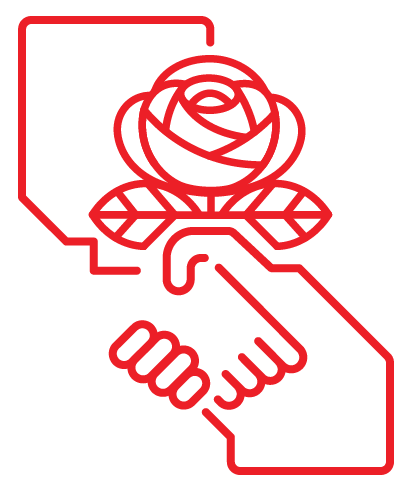Cone bites Robotaxi
Rhinos lining up for dinner…or autonomous vehicles disabled by activists with traffic cones?
Over the past few months, there has been a sustained direct action campaign against robotaxis (also called autonomous vehicles, or AVs) in San Francisco. Activists have been using the humble traffic cone to disable AVs in their tracks and catalyze broad community resistance. Members of San Francisco DSA, and allies such as the anti-car direct action group Safe Street Rebel, participated in both public comments and direct actions armed with clear analysis of car dominance within the capitalist system. This article will examine both the innovative direct action and the reason DSA members in California should be concerned with AVs.
The campaign started with a pending vote by the California Public Utilities Commission on August 10 to allow AV fleets to expand service. Rather than a step forward, AVs represent an entrenchment of car dominance. If allowed to become as pervasive as their backers want, they’ll cannibalize public transit ridership just as Uber, Lyft, and (Cruise’s owner) GM did before them. They’re effectively above the law: driverless cars cannot be cited for moving violations, and ecological impacts and mass surveillance are huge concerns as well.
Strategic Luddites
San Francisco capital is dominated by the tech industry and innovation fetishism. Whenever new technology is challenged, proponents will claim that the resisting side is “Luddite”. In this case the comparison is apt, but not exactly for the reasons they think. The original 19th century Luddites were artisans who sabotaged machines in a specific, strategic fight against the devaluation of their labor. AVs similarly devalue labor, hiding ghost work in call centers and support cars, making workers more alienated, atomized, and easier to exploit.
Activists found that placing a cone on the hood of an AV immobilizes it by blocking its sensors from “seeing” what is in front of the car. In the interest of safety, activists only coned empty cars and avoided coning AVs in potentially dangerous places like intersections or high-speed thoroughfares, or in bus stops.
After releasing a video kicking off the campaign, the activists received immediate and widespread media coverage. The whimsical cone tactic was seen as funny and interesting, and strongly resonated with public anger.
The ability to disable the car without causing permanent damage rides the line of provocative and disruptive without significant arrest risk. SFPD’s stated objection to robot cars didn’t hurt either, leading Cruise to hire private security to protect its cars. The activists were able to use social media to generate negative publicity for Cruise, and the company largely backed off the security.
The overall dynamics over the role of AVs in San Francisco has been unusual. Instead of organizing against the City, anti-AV members of DSA SF and Safe Street Rebel were aligned with the City against the state of California. The fire and police departments and SFMTA, the local transit agency, have been vocally concerned about challenges AVs pose to their day-to-day operations. The fire department has noted over 70 incidents of Cruise cars delaying emergency vehicles, most notably when one delayed an ambulance transporting a pedestrian who later died of their injuries at the hospital. The CPUC is a largely captured, governor-appointed regulatory body, with close ties to industry such as PG&E; one CPUC commissioner previously spent three years as managing counsel for Cruise.
The role(s) of labor
During the course of the anti-AV campaign, activists found themselves strongly aligned with part of the labor movement. Unions such as the San Francisco Taxi Workers Alliance, Teamsters, United Food and Commercial Workers, and Service Employees (SEIU) Local 1021 all gave statements in opposition to robot cars. However, SEIU Local 87 and International Brotherhood of Electrical Workers (IBEW) Local 6 signed a labor agreement with Cruise and spoke in favor of expansion. Labor unions will not have perfect takes on every issue. It’s up to organizers to cultivate solidarity and trust to support them in the right direction. A just transition for the workers whose livelihoods are tied up in car dominance is needed to break it. This angle resonated especially with taxi drivers, who, for instance, could be hired as bus drivers and paratransit operators.
The DSA SF affiliation with the campaign was mostly indirect, but originated from the Free Muni Full Service campaign for transit justice, understanding that a “transit-first city” should not prioritize AVs. It is useful for organizers to wear many hats for different tactics. In addition to some members engaging in direct action, DSA SF ecosocialists mobilized for public comment at the August 10 CPUC meeting. After hours of comments, both from concerned members of the public, and Waymo employees in the form of an astroturf organization, the CPUC voted 3-1 to allow expansion of robotaxi service. This battle was lost, but the struggle continues in San Francisco and cities beyond. AVs can now run rampant in SF, and they may come to other California cities soon; socialists and transit organizers should be ready.
Laughing and Thinking
This campaign demonstrates a number of interesting tactics that can be useful for future DSA projects. Direct action and street theater, combined with a strong media strategy, can be extremely effective at setting the agenda. Organized labor often has its own perspectives, but solidarity can help orient it toward the broader socialist project. Socialists should always be identifying and exploiting internal tensions within the state apparatus, and finding ways to democratize its power. Most of all, this action succeeded to the extent that it did because at its core it’s funny; it made people laugh and think at the same time. Though there was no immediate victory in the halls of power, the campaign demonstrated mass opposition to robot cars and put an effective tactic (and with it, power) back in the hands of the people.


